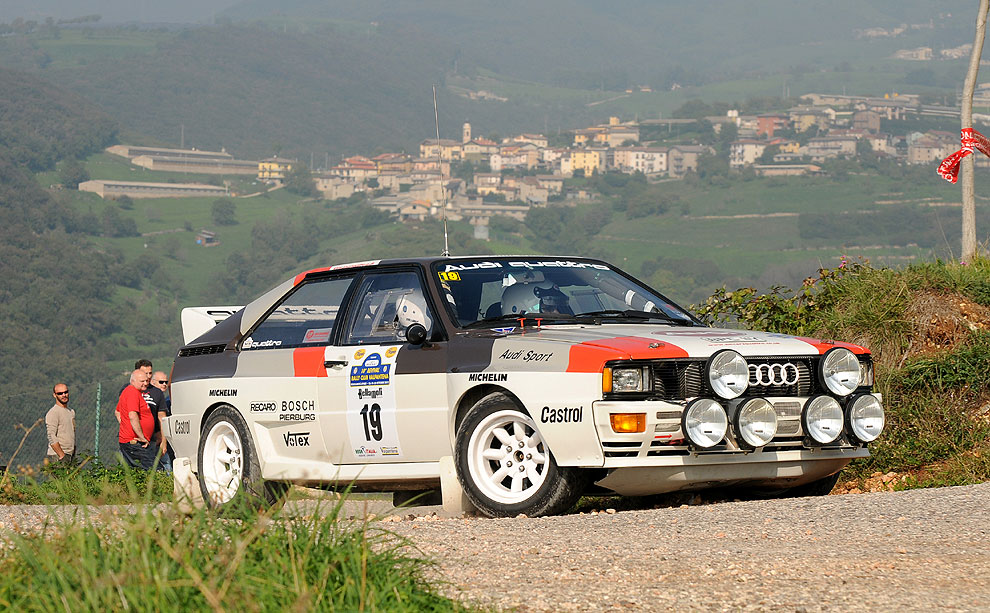Background
The Quattro story began long before Group B era, in 1976 to be precise. It was then that Volkswagen approached Audi with a request to build a number of prototype four wheel drive vehicles for consideration by the German army as their original choice had never made it into production. The vehicle that the Army chose was called the Iltis and this could have remained just another military vehicle had it not been for the fact that the underpowered ugly four wheel drive vehicle ran rings around the top spec Audi 100 during winter testing in Norway.
As a result discussions were hastily had back at Audi headquarters as to the feasibility of fitting a four wheel drive system into one of their mainstream vehicles. The first test vehicle was a naturally aspirated 115bhp Audi A80, which proved the four wheel drive system gave the grip but the added weight sapped too much performance. So after some head scratching the 2.1 ltr turbo engine from the new Audi 100 was sourced.
Audi now had a secretly proven four wheel drive car, mated to a powerful turbo charged engine but no arena to show it off as the WRC rules at the time specifically banned four wheel drive cars from competing. Therefore discussions between Audi, the FIA and the other constructors were held and as the only four wheel drive vehicle that Audi apparently had was the Iltis the rules were swiftly relaxed to allow the “75bhp Army Truck” to compete. You can imagine their shock when the Audi Quattro Coupe was unveiled to the world at the 1980 Geneva Motorshow.
The Quattro rally car was homologated into Group 4 on the 1st January 1981, making its WRC debut on the Monte Carlo Rally in the hands of Hannu Mikkola. The car’s performance over the first eight stages caused teams to cry foul as in the icy and snowy conditions the car left the field in its blizzard. Unfortunately due to the team’s inexperience and the newness of the car both works cars failed to finish the event.
The next event was Rally Sweden which went much better and saw Hannu collect his first win in a Quattro and perhaps more importantly the birth of a legend.
1983 saw the Quattro modified to Group B regulations, with the first incarnation being the A1 launched in January. The ‘A’ signifies the fact that the cylinder block was constructed from Aluminium having previously been constructed from Iron. The A2 followed shortly afterwards and saw the engine capacity reduced from 2,144 cc to 2,109cc, which meant that the Quattro could compete in the up to 3 ltr class (after the turbo factoring was taken into account) and so benefit from a reduction of 140kgs in minimum car weight.
1984 saw the introduction of the Sport Quattro (commonly abbreviated to S1), which was a shortened version of the A2.
This Car
BPC11Y, was converted from a genuine 1983 Audi Quattro by AM Cars Motorsport Ltd. The car has been built to a high standard using many original parts, a 20 Valve 5 cylinder turbocharged engine with 430 BHP.
This car has participated in many hillclimbs and sprints such as Wiscombe Park, Longleat Safari Park and Colerne where it has won its class on many occasions. The car has also had many invitations for demonstration rallies both national and international, these include Rally Sunseeker, Manx Rally, Valpantena Rally, Chatsworth Rally stages, Cornbury Park, Castle Combe Rally Day, Race Retro and the 2012, 2013 and 2014 Eifel Historic Rallye Festival, 2012,2013 and 2014 Valpantena Rallye and 2013 Rally Legends. This year the car participated in the Eifel Rallye Festival, Valpantena Rallye and Rallye Legends, Goodwood Festival of Speed and the Transmiera Rally Festival. It has successfully completed all these rallies and is currently being refurbished for next year’s season.
Technical
Engine : Five-cylinder, 2.1ltr, in-line, longitudinally mounted in the front of the car, four valves per cylinder, 370 bhp
Induction : Fuel Injected, Turbocharged

